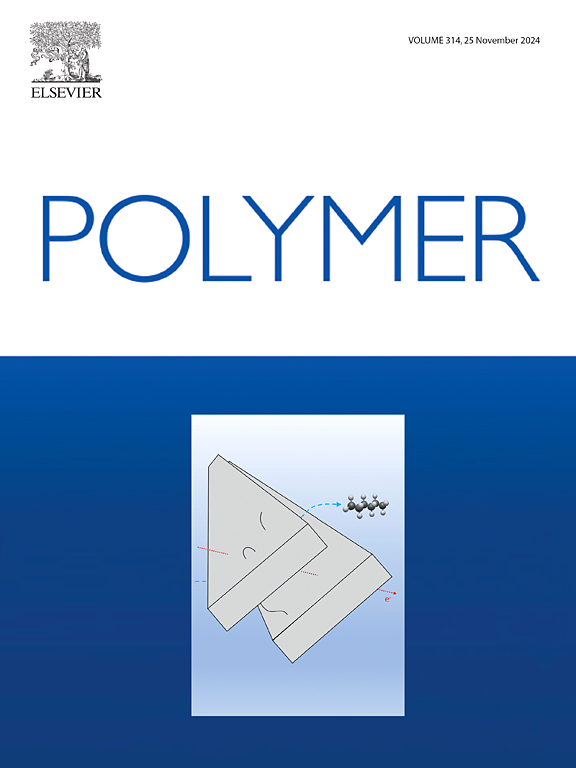增韧环氧树脂:网络结构和流变行为的最新进展
IF 4.5
2区 化学
Q2 POLYMER SCIENCE
引用次数: 0
摘要
环氧树脂因其优异的机械强度、耐化学性和界面附着力被广泛应用于航空航天、电子封装和高性能复合材料中。然而,固化网络的高交联密度固有地赋予其脆性,限制了其在冲击载荷和极端环境下的使用性能。为了实现强度和韧性的协同增强,最近的工作集中在工程多尺度增韧网络和利用流变学技术来阐明其结构演变。在这篇综述中,我们通过将网络结构分类为非均相体系(包括橡胶、热塑性塑料、核壳聚合物和纳米填料)和均相体系(超支化聚合物和生物基材料),系统地研究了环氧树脂的增韧策略,详细介绍了它们的增韧机制和制造方法。我们进一步讨论了粒子分散控制方法及其对界面相互作用和宏观力学行为的影响。通过线性和非线性流变学表征,揭示了固化过程中的粘弹性响应和网络发展过程。分析了互穿双网络和相分离形态等协同增韧机制,强调了它们内在的结构-性能相关性。最后,我们确定了当前在分散稳定性、可持续合成和结构性质建模方面的挑战,并概述了未来的方向,包括多尺度原位表征和机器学习辅助配方设计。本文旨在为高性能、环保、多功能环氧树脂体系的合理设计和应用提供理论基础和实践见解。本文章由计算机程序翻译,如有差异,请以英文原文为准。


Toughening epoxy resins: Recent advances in network architectures and rheological behavior
Epoxy resins are extensively employed in aerospace, electronic encapsulation, and high‐performance composites owing to their exceptional mechanical strength, chemical resistance, and interfacial adhesion. However, the high crosslink density of cured networks inherently imparts brittleness, limiting their service performance under impact loading and extreme environments. To achieve a synergistic enhancement of strength and toughness, recent efforts have focused on engineering multiscale toughening networks and leveraging rheological techniques to elucidate their structural evolution. In this review, we systematically examine epoxy resin toughening strategies by categorizing network architectures into heterogeneous systems (including rubbers, thermoplastics, core–shell polymers, and nanofillers) and homogeneous systems (hyperbranched polymers and bio-based materials), detailing their toughening mechanisms and fabrication approaches. We further discuss particle dispersion control methods and their influence on interfacial interactions and macroscopic mechanical behavior. Through both linear and nonlinear rheological characterization, we reveal the viscoelastic response and network development processes during curing. Synergistic toughening mechanisms such as interpenetrating dual networks and phase-separated morphologies are analyzed to highlight their intrinsic structure–property correlations. Finally, we identify current challenges in dispersion stability, sustainable synthesis, and structure–property modeling, and we outline prospective directions including multiscale in situ characterization and machine-learning-assisted formulation design. This comprehensive review aims to provide theoretical foundations and practical insights for the rational design and application of high-performance, eco-friendly, multifunctional epoxy resin systems.
求助全文
通过发布文献求助,成功后即可免费获取论文全文。
去求助
来源期刊

Polymer
化学-高分子科学
CiteScore
7.90
自引率
8.70%
发文量
959
审稿时长
32 days
期刊介绍:
Polymer is an interdisciplinary journal dedicated to publishing innovative and significant advances in Polymer Physics, Chemistry and Technology. We welcome submissions on polymer hybrids, nanocomposites, characterisation and self-assembly. Polymer also publishes work on the technological application of polymers in energy and optoelectronics.
The main scope is covered but not limited to the following core areas:
Polymer Materials
Nanocomposites and hybrid nanomaterials
Polymer blends, films, fibres, networks and porous materials
Physical Characterization
Characterisation, modelling and simulation* of molecular and materials properties in bulk, solution, and thin films
Polymer Engineering
Advanced multiscale processing methods
Polymer Synthesis, Modification and Self-assembly
Including designer polymer architectures, mechanisms and kinetics, and supramolecular polymerization
Technological Applications
Polymers for energy generation and storage
Polymer membranes for separation technology
Polymers for opto- and microelectronics.
 求助内容:
求助内容: 应助结果提醒方式:
应助结果提醒方式:


